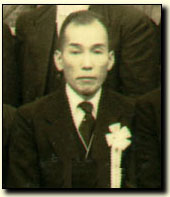
Biography In Northern Kyoto, in a town called Hanase, where groves of cedars stand tall and beautiful, Yonejiro Nakatsu was born the third son. When he was still a child, they would move together as a family to Kyoto City; to the north of the Imperial Palace, and where Doshisha Women's University campus currently stands. Now nothing remains of the old house where his youth was spent. Yoshie Nakatsu's clearheadedness as a child was a sign of his future success as a working member of society. I know very few people who had his love and pride for Kyoto. He sometimes shared his knowledge of the old days with stories for the children. He was fond of Gion, the famous entertainment district of Kyoto, he followed current styles and took an avid interest the world of Tea Ceremony; he also enjoyed composing haikai. There was even one time during summer when while sitting on the edge of the veranda, with a song book propped in front of him, he entertained me with a song. In the year before his death I fondly remember one event in particular. His youngest daughter sent him a cassette tape for recording and on it he recorded one section from the famous piece "Hagoromono." This tape has become a keepsake of mine and his memory. He held the respect of many while making a name for himself as an amateur inventor. When encountering things in his everyday life he had a keen ability to notice what others didn't. If there were something that could stand for improvement or that would make things easier, he never failed to point it out to us. He tasted the bitter side of life when he spent over twelve years trying to develop a method for transferring photo images to fabric. He finally met with success as his invention became an official Japanese patent and was recognized by the Ministry. This surely was one of his happiest moments, achieving his lifetime goal. Stubborness and pride are things for men to be proud of. On the other hand, Yoshio Nakatsu had a warm heart and was always surrounded by people. In order to soothe the loneliness of sickness he hung many photos of the smiling faces of his friends so there was always someone close at hand he could talk to. He was moved deeply by the compassion of others. For fifteen years he fought his own personal battle with his sickness. Yet he was always looking towards the future. He continued to tend to his duties and supervise his business outstandingly, admired by those around him. As his condition gradually worsened late in the year in Showa 42 (1967) he retired in order to recuperate and tend to his sickness. He was blessed with pleasant days during the last years of his life until February, Showa 44 (1969), when his sickness took a turn for the worse and his condition deteriorated swiftly. There was nothing that could be done. On March 16th, before daybreak, Yoshio Nakatsu fell into eternal sleep. He urged each of his daughters to follow her individual path and with no lasting regrets he left behind words for each family member individually, and a feeling of ease and affection. His was truly a fortunate life. This biography was written by his wife, Hide Nakatsu (1910-2002), shortly after Yoshio Nakatsu passed away in 1969. |